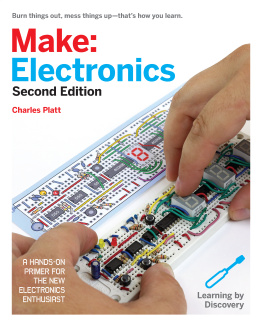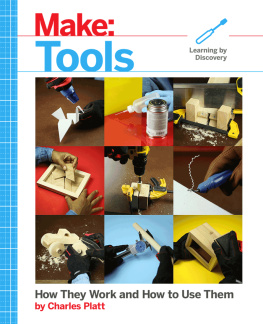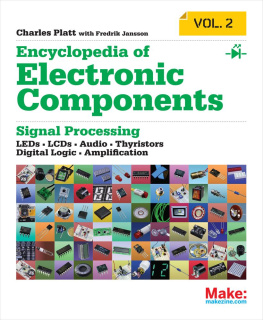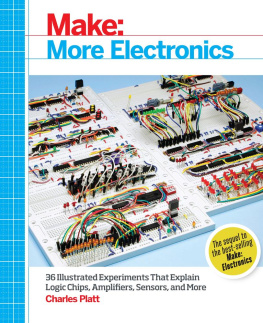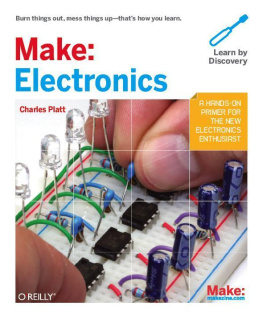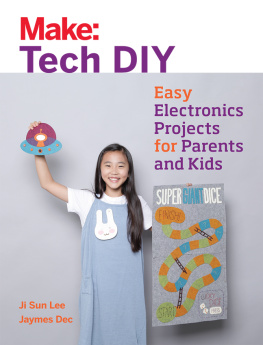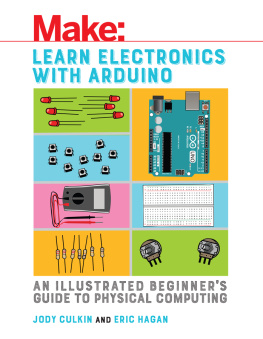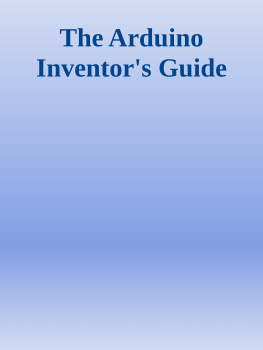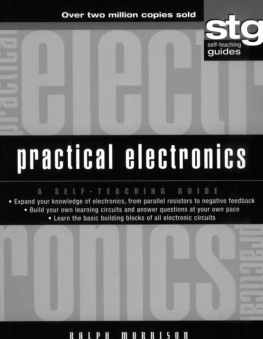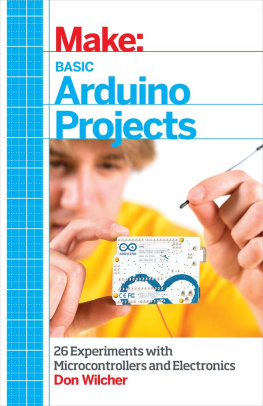Make: Electronics
by Charles Platt
Copyright 2015 Charles Platt. All rights reserved.
Printed in Canada.
Published by Maker Media, Inc., 1160 Battery Street East, Suite 125, San Francisco, CA 94111.
Maker Media books may be purchased for educational, business, or sales promotional use. Online editions are also available for most titles (http://safaribooksonline.com). For more information, contact our corporate/institutional sales department: 800-998-9938 or corporate@oreilly.com .
- Editor: Brian Jepson
- Production Editor: Nicole Shelby
- Proofreader: Charles Roumeliotis
- Indexer: Charles Platt
- Interior Designer: David Futato
- Cover Designers: Marc de Vinck and Charles Platt
- Interior Photographs and Illustrations: Charles Platt
- September 2015: Second Edition
- December 2009: First Edition
Revision History for the Second Edition
- 2015-08-07: First Release
See http://oreilly.com/catalog/errata.csp?isbn=9781680450262 for release details.
The Make logo is a registered trademark of Maker Media, Inc. Make: Electronics, the cover image, and related trade dress are trademarks of Maker Media, Inc.
While the publisher and the author have used good faith efforts to ensure that the information and instructions contained in this work are accurate, the publisher and the author disclaim all responsibility for errors or omissions, including without limitation responsibility for damages resulting from the use of or reliance on this work. Use of the information and instructions contained in this work is at your own risk. If any code samples or other technology this work contains or describes is subject to open source licenses or the intellectual property rights of others, it is your responsibility to ensure that your use thereof complies with such licenses and/or rights.
978-1-680-45026-2
[TI]
Dedication
To readers of the first edition of Make: Electronics who contributed many ideas and suggestions for this second edition. In particular: Jeremy Frank, Russ Sprouse, Darral Teeples, Andrew Shaw, Brian Good, Behram Patel, Brian Smith, Gary White, Tom Malone, Joe Everhart, Don Girvin, Marshall Magee, Albert Qin, Vida John, Mark Jones, Chris Silva, and Warren Smith. Several of them also volunteered to review the text for errors. Feedback from my readers continues to be an amazing resource.
Acknowledgments
I discovered electronics with my school friends. We were nerds before the word existed. Patrick Fagg, Hugh Levinson, Graham Rogers, and John Witty showed me some of the possibilities.
It was Mark Frauenfelder who nudged me back into the habit of making things. Gareth Branwyn facilitated Make: Electronics, and Brian Jepson enabled the sequel and this new edition. They are three of the best editors I have known, and they are also three of my favorite people. Most writers are not so fortunate.
I am also grateful to Dale Dougherty for starting something that I never imagined could become so significant, and for welcoming me as a participant.
Russ Sprouse and Anthony Golin built and tested the circuits. Technical fact checking was provided by Philipp Marek, Fredrik Jansson, and Steve Conklin. Dont blame them if there are still any errors in this book. Its much easier for me to make an error than it is for someone else to find it.
Whats New in the Second Edition
All of the text from the first edition of this book has been rewritten, and most of the photographs and schematics have been replaced.
Single-bus breadboards are now used throughout (as in Make: More Electronics) to reduce the risk of wiring errors. This change entailed rebuilding the circuits, but I believe it was worthwhile.
Diagrams showing component placement are now used instead of photographs of breadboarded circuits. I think the diagrams are clearer.
Internal views of breadboard connections have been redrawn to match the revisions noted above.
New photographs of tools and supplies have been included. For small items, I have used a ruled background to indicate the scale.
Where possible, I have substituted components that cost less. I have also reduced the range that you need to buy.
Three experiments have been completely revised:
The Nice Dice project that used LS-series 74xx chips in the first edition now uses 74HCxx chips, to be consistent with the rest of the book and with modern usage.
The project using a unijunction transistor has been replaced with an astable multivibrator circuit using two bipolar transistors.
The section on microcontrollers now recognizes that the Arduino has become the most popular choice in the Maker community.
In addition, two projects involving workshop fabrication using ABS plastic have been omitted, as many readers did not seem to find them useful.
All the page layouts have been changed to make them easily adaptable for handheld devices. The formatting is controlled by a plaintext markup language, so that future revisions will be simpler and quicker. We want the book to remain relevant and useful for many more years to come.
--Charles Platt, 2015
Preface: How to Have Fun with This Book
Everyone uses electronic devices, but most of us dont really know what goes on inside them.
You may feel that you dont need to know. You can drive a car without understanding the workings of an internal combustion engine, so why should you learn about electricity and electronics?
I think there are three reasons:
By learning how technology works, you become better able to control your world instead of being controlled by it. When you run into problems, you can solve them instead of feeling frustrated by them.
Learning about electronics can be fun, so long as you approach the process in the right way. It is also very affordable.
Knowledge of electronics can enhance your value as an employee, or perhaps even lead to a whole new career.
Learning by Discovery
Most introductory guides begin by using definitions and theory to explain some fundamental concepts. Circuits are included to demonstrate what you have been told.
Science education in schools often follows a similar plan. I think of this as learning by explanation.
This book works the other way around. I want you to dive right in and start putting components together without necessarily knowing what to expect. As you see what happens, you will figure out whats going on. This is Learning by Discovery, which I believe is more fun, more interesting, and more memorable.
Working on an exploratory basis, you run the risk of making mistakes. But I dont see this as a bad thing, because mistakes are a valuable way to learn. I want you to burn things out and mess things up, to see for yourself the behavior and limitations of the parts that you are dealing with. The very low voltages used throughout this book may damage sensitive components, but will not damage you.
The key requirement of Learning by Discovery is that it has to be hands-on. You can derive some value from this book merely by reading it, but you will enjoy a much more valuable experience if you perform the experiments yourself.
Fortunately, the tools and components that you need are inexpensive. Hobby electronics should not cost significantly more than a recreation such as needlepoint, and you dont need a workshop. Everything can be done on a tabletop.
Will It Be Difficult?
I assume that youre beginning with no prior knowledge. Consequently, the first few experiments will be extremely simple, and you wont even use prototyping boards or a soldering iron.

